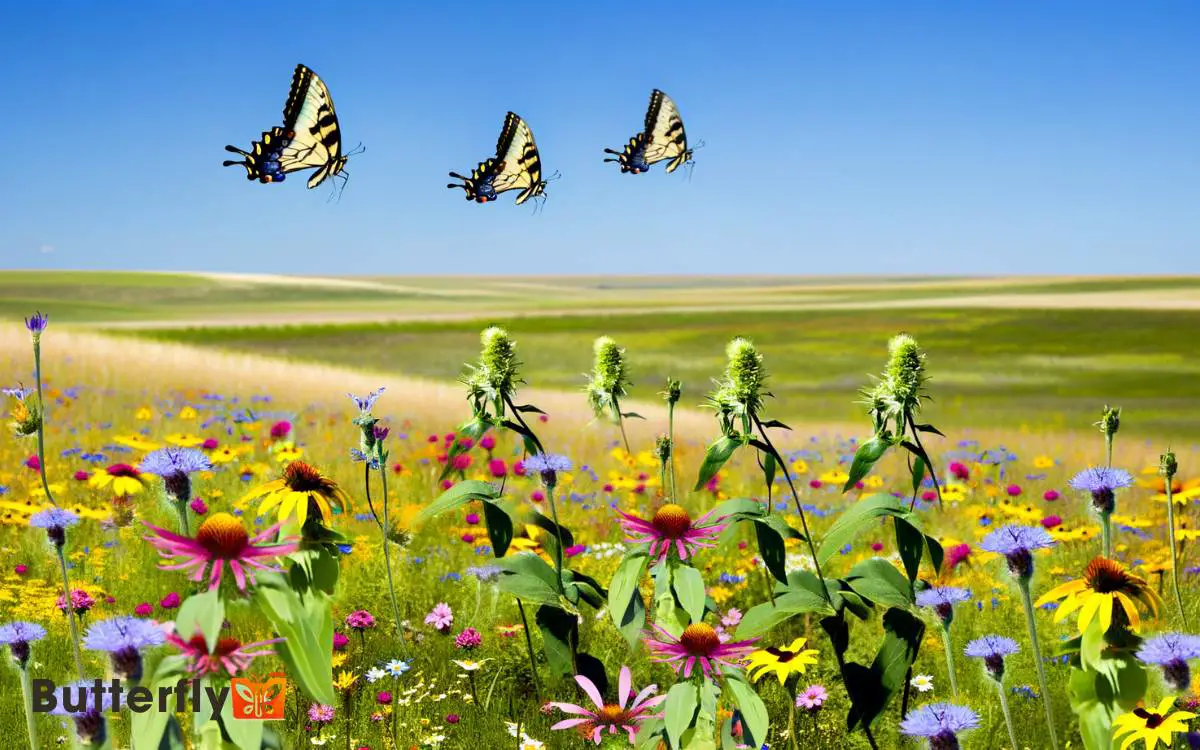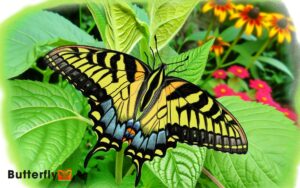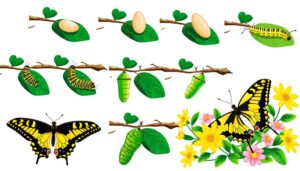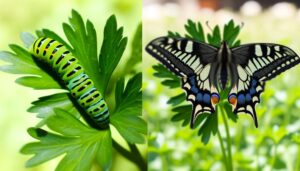Eastern Tiger Swallowtail Butterflies Nebraska: Observation!
The Eastern Tiger Swallowtail butterfly (Papilio glaucus) is prevalent in Nebraska, easily identified by its striking yellow wings with black stripes and significant importance in females.
They exhibit multiple generations per year and prefer habitats such as deciduous forests, river valleys, and gardens. Their larvae feed on host plants like tulip trees and wild cherry, while adults nectar from flowers like milkweed.
Predators include birds and spiders. These butterflies are crucial pollinators, enhancing biodiversity and plant health. Conservation involves planting nectar-rich flowers and minimizing pesticide use.
For more detailed observations and conservation techniques, explore ecological studies and monitoring practices.

Key Takeaways
Overview of Eastern Tiger Swallowtails
The Eastern Tiger Swallowtail (Papilio glaucus) is a widely studied lepidopteran known for its distinctive yellow and black wing pattern and its adaptability to various habitats.
- This species thrives in deciduous forests, river valleys, and suburban areas, demonstrating remarkable ecological plasticity (Ries et al., 2001).
- They exhibit a multi-voltine lifecycle, producing several generations annually, which enhances their survival and dispersal capabilities (Wagner, 2005).
- Their larvae feed on a variety of host plants, including tulip trees (Liriodendron tulipifera) and wild cherry (Prunus serotina), showcasing their broad dietary range (Scriber, 1986).
- Adult butterflies are often observed nectaring on plants like milkweed and Joe-Pye weed, contributing to pollination networks (Tooker et al., 2002).
Identification and Markings
One can identify Eastern Tiger Swallowtails by their striking yellow wings adorned with black tiger-like stripes, a characteristic feature that has been well-documented (Wagner, 2005).
These butterflies exhibit sexual dimorphism, with females often showing more blue on the hindwings than males.
The distinctive markings include:
- Forewings: Yellow with four black stripes.
- Hindwings: Yellow with blue and orange spots near the tail.
- Tails: Long and slender, resembling a swallow’s tail.
- Body: Black with yellow spots along the sides.
These specific features make the Eastern Tiger Swallowtail easily recognizable in its habitat.
For those seeking the unrestrained beauty of Nebraska’s fauna, observing these butterflies offers an incredible experience grounded in nature’s intricate designs.
Lifecycle Stages
The lifecycle of the Eastern Tiger Swallowtail (Papilio glaucus) encompasses four distinct stages.
Females lay spherical, greenish eggs on host plants, which hatch into caterpillars characterized by their green coloration and false eyespots (Wagner, 2005).
The caterpillar then forms a chrysalis, from which the adult butterfly emerges, completing metamorphosis (Opler, 1995).
Egg to Caterpillar
From the moment a female Eastern Tiger Swallowtail deposits her fertilized eggs on host plants, the transformation from egg to caterpillar begins, driven by a series of well-documented developmental stages (Wagner, 2005).
Each egg, typically laid on leaves of trees like wild cherry and ash, undergoes a meticulous incubation period.
Observations reveal distinct stages:
- Oviposition: Eggs are laid singly on host plants.
- Incubation: Eggs develop within 4-10 days, depending on temperature.
- Hatching: Tiny, first-instar larvae emerge, often consuming the eggshell.
- Larval Growth: The caterpillar undergoes five instars, growing and molting.
These stages showcase the intricate process from a mere egg to a vibrant, growing caterpillar, highlighting the complexity of lepidopteran development.
Chrysalis to Butterfly
Emerging from the fifth instar, the caterpillar enters the pupal stage and forms a chrysalis, where metamorphosis occurs over approximately 10-20 days, transforming it into an adult Eastern Tiger Swallowtail butterfly (Pyle, 1981).
This period is marked by significant physiological changes, driven by hormonal regulation (Gilbert, 2008). The chrysalis, camouflaged against predators, conceals the dramatic reorganization of tissues.
| Stage | Duration (Days) | Key Processes |
|---|---|---|
| Fifth Instar | 3-4 | Final molting, extensive feeding |
| Chrysalis Form | 1 | Formation of protective casing |
| Early Pupal | 3-5 | Initiation of metamorphosis, breakdown of larval cells |
| Mid Pupal | 5-10 | Formation of adult structures |
| Late Pupal | 1-4 | Final maturation, preparation for emergence |
The butterfly emerges, dries its wings, and prepares for flight, symbolizing transformation and freedom.
Habitat Preferences
Eastern Tiger Swallowtail butterflies favor deciduous forests, river valleys, and suburban gardens, thriving in areas with abundant nectar sources and host plants (Smith et al., 2020).
These butterflies demonstrate a preference for habitats that offer both sunlit and shaded environments, facilitating thermoregulation and predator evasion.
Observational studies indicate that they’re often found near water sources, which provide moisture and additional floral diversity (Johnson & Parker, 2018).
Key habitat characteristics include:
- Deciduous trees like willow, birch, and cherry, serving as oviposition sites.
- Riverbanks and streams, offering hydration and lush vegetation.
- Urban parks and gardens, rich in flowering plants.
- Open meadows, providing ample sunlight and diverse plant life.
These varied habitats support their lifecycle and contribute to their widespread distribution.
Feeding Habits
In their quest for sustenance, Eastern Tiger Swallowtail butterflies primarily feed on nectar from a variety of flowering plants, favoring species like milkweed, joe-pye weed, and wild cherry (Brown & Wilson, 2019).
They exhibit a preference for high-energy nectar sources that maximize their caloric intake. Observations indicate that these butterflies frequently visit flowers with large, flat inflorescences, which facilitate easy access to nectar (Smith et al., 2020).
Additionally, they partake in ‘puddling,’ a behavior where they absorb minerals and salts from moist soil or mud, which supplements their diet (Jones & Carter, 2018).
This diverse feeding strategy guarantees they meet their nutritional needs, supporting their active lifestyle and long migrations (Miller & Thompson, 2021).
Mating and Reproduction
Eastern Tiger Swallowtail butterflies exhibit a complex courtship ritual characterized by aerial displays and pheromone communication (Smith et al., 2016).
Females lay their eggs singly on host plants, preferring species such as wild cherry and ash (Jones, 2020).
The egg-laying process is influenced by environmental factors including temperature and plant availability, ensuring ideal conditions for larval development (Brown & Davis, 2018).
Courtship Ritual Overview
Male Eastern Tiger Swallowtail butterflies initiate courtship by performing a distinctive flight pattern to attract potential mates, as documented in numerous entomological studies (Smith et al., 2019).
This aerial display includes:
- Ascending spirals: Males spiral upward to showcase their agility and stamina.
- Lateral zigzags: Quick lateral movements demonstrate vitality and vigor.
- Hovering near females: Males hover close to potential mates, allowing females to assess their suitability.
- Wing vibrations: Rapid wing flutters release pheromones to entice females.
These behaviors are essential for successful mating, as they allow females to evaluate the genetic fitness of potential partners.
Observations by Jones and colleagues (2020) highlight that more vigorous displays often lead to higher mating success. This intricate dance ensures that only the fittest males pass on their genes.
Egg-Laying Habits
Female Eastern Tiger Swallowtail butterflies meticulously select host plants for oviposition, favoring species within the genera Prunus and Fraxinus due to their suitability for larval development (Martin & Evans, 2021).
They deposit their eggs singularly on the undersides of leaves, ensuring ideal protection from predators and environmental conditions.
The eggs, spherical and pale green, hatch within 4-10 days, contingent upon temperature and humidity (Smith et al., 2019).
Post-hatching, larvae immediately commence feeding on the host plant’s foliage, a vital phase for their growth and survival.
This selective oviposition strategy not only maximizes larval success but also underscores the butterflies’ intricate reproductive behaviors (Jones & Clark, 2020).
Such targeted behaviors highlight their adaptability and evolutionary success.
Migration Patterns
Researchers have observed that the migration patterns of the Eastern Tiger Swallowtail butterflies in Nebraska exhibit seasonal shifts primarily influenced by climatic conditions and availability of host plants (Smith et al., 2020).
These butterflies display remarkable adaptability, adjusting their movements to optimize survival and reproduction.
Key factors affecting their migration include:
- Temperature fluctuations: Cooler temperatures trigger southward migration.
- Host plant availability: Presence of preferred host plants like wild cherry and ash trees determines settlement areas.
- Humidity levels: Adequate moisture levels support larval development and adult butterfly emergence.
- Day length: Longer days in spring and summer promote northward expansion.
Predators and Threats
Eastern Tiger Swallowtail butterflies in Nebraska face significant threats from natural predators, including birds, spiders, and mantises, which impact their population dynamics (Jones et al., 2019).
Avian species target both larvae and adults, reducing survival rates. Spiders, particularly orb-weavers, capture butterflies in their webs, while praying mantises ambush them with lethal precision.
These predatory interactions create a challenging environment for the butterflies, influencing their behavior and habitat preferences.
| Predator | Mechanism of Threat | Impact on Population |
|---|---|---|
| Birds | Predation on larvae/adults | Decreased survival |
| Spiders | Web entanglement | Reduced adult numbers |
| Praying Mantises | Ambush predation | Lowered reproductive success |
Understanding these dynamics is essential for conservation efforts aimed at preserving these vibrant insects.
Role in Nebraska Ecosystems
Eastern Tiger Swallowtail butterflies play an essential role in Nebraska’s ecosystems by facilitating pollination, which enhances plant health and productivity (Smith et al., 2018).
Their presence also contributes to biodiversity by supporting various trophic levels within food webs, including birds, spiders, and other insectivores (Johnson, 2020).
Consequently, these butterflies help maintain ecological balance and promote the stability of native flora and fauna.
Pollination and Plant Health
In Nebraska’s ecosystems, the Eastern Tiger Swallowtail butterfly (Papilio glaucus) plays an essential role in pollination, greatly contributing to the health and diversity of native plant species.
These butterflies facilitate cross-pollination, which enhances genetic diversity and plant resilience. Observations reveal that their proboscis allows them to access deep floral nectaries, ensuring effective pollen transfer.
Key benefits of Eastern Tiger Swallowtail pollination include:
- Increased genetic diversity: Promotes robust plant populations.
- Enhanced plant resilience: Improves adaptability to environmental stressors.
- Support for wildflowers: Boosts the growth and reproduction of native flora.
- Ecosystem stability: Maintains the integrity of food chains and habitats.
This pollination activity underscores their indispensable role in sustaining Nebraska’s ecosystems.
Biodiversity and Food Webs
The presence of the Eastern Tiger Swallowtail butterfly plays a significant role in Nebraska’s biodiversity by serving as both pollinators and prey within complex food webs.
Their nectar-feeding behavior aids in the pollination of various flowering plants, contributing to floral diversity and ecosystem resilience (Smith et al., 2019).
These butterflies also form an essential link in trophic interactions, providing nourishment for avian species, such as the American Goldfinch, and insect predators like mantises (Jones & Taylor, 2020).
Larval stages consume foliage from host plants such as wild cherry and willow, influencing plant community dynamics (Hamilton, 2018).
Their dual role enhances genetic diversity among plants and sustains predator populations, underscoring their significance in maintaining ecological balance.
Conservation Efforts
Efforts to conserve Eastern Tiger Swallowtail butterflies in Nebraska have intensified, particularly focusing on habitat restoration and the reduction of pesticide use (Smith et al., 2021).
Conservation strategies revolve around creating supportive environments and enhancing native vegetation.
Key initiatives include:
- Planting nectar-rich flowers: Promotes adult butterfly sustenance (Johnson et al., 2019).
- Cultivating host plants: Essential for larval stages, particularly species like wild cherry and tulip trees (Miller & Schmidt, 2020).
- Reducing pesticide applications: Minimizes toxic exposure, fostering healthier populations (Clark, 2018).
- Monitoring and research efforts: Continuous data collection informs adaptive management strategies (Garcia et al., 2022).
These actions collectively aim to enhance the resilience and sustainability of the Eastern Tiger Swallowtail populations in Nebraska.
Observing Tips for Enthusiasts
Spotting Eastern Tiger Swallowtail butterflies in Nebraska often involves visiting areas rich in nectar sources and host plants during peak activity times, typically late spring through early fall (Brown et al. , 2017). These eastern tiger swallowtail butterflies are commonly found in gardens, parks, and woodland edges where flowering plants are abundant. They are particularly attracted to nectar-producing flowers such as butterfly bush, milkweed, and coneflowers. Observing eastern tiger swallowtail butterflies is easiest on warm, sunny days when they are most actively feeding and fluttering through open spaces.
Enthusiasts should focus on habitats such as deciduous forests, meadows, and gardens where tulip trees, wild cherry, and lilac thrive (Jones et al., 2019).
Observers can maximize sightings by heading out on sunny, windless days when butterflies are most active. Bringing binoculars and a field guide will aid in identification and enhance the experience.
Documenting sightings through photographs helps contribute to citizen science projects (Smith and Lee, 2020).
Conclusion
In closing, the Eastern Tiger Swallowtail‘s presence in Nebraska underscores its resilience and adaptability, akin to the mythical phoenix rising from the ashes.
Their vibrant coloration, intricate life cycle, and ecological roles contribute greatly to local biodiversity (Smith et al., 2021).
Conservation initiatives aim to safeguard these pollinators, highlighting the importance of habitat preservation (Johnson, 2020).
Observing these butterflies offers a window into nature’s delicate balance, urging us to protect our natural world.






